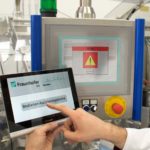
The future and prosperity of entire countries depend on the production of goods, just as many jobs in the USA and worldwide. The future of digitalized manufacturing and Industrie 4.0 rests entirely upon the ability to pool expertise and resources.
Fraunhofer’s interdisciplinary systems expertise sparks the new ideas that meet the challenges of a changing world and helps create customized solutions right along the value chain. Visitors to the joint Fraunhofer booth on this year’s International Manufacturing Technology Show IMTS in Chicago can experience how a vibrant mix of new technology in the fields of augmented reality as a service, artificial intelligence, cybersecurity and data sovereignty, sensor and actuator systems, digital engineering, human-machine interaction and smart materials is reshaping the future. Digitalized production technologies are transforming business models and changing market structures. Concepts like Industrie 4.0 and the Internet of Things represent a paradigm shift in business and society, generated by a growing number of increasingly connected and automated devices, machines and products. Forecasts indicate that by 2020, 32 billion objects will be connected to the Internet. The economic impact of digitalization is staggering: studies show that in six economically important industries alone, Industrie 4.0 will give rise to productivity increases in the tens of millions by 2025. “But from the new opportunities that accompany digitalization grow expectations. As well as being cost-efficient and sustainable, connected production and work processes must be secure, flexible and intuitive”, says Fraunhofer President Prof. Reimund Neugebauer. “This has implications for individualized production with batch sizes as small as one to the same extent it does for connected large scale production, logistics and communication.”
Digitalized manufacturing: Trends, perspectives and business opportunities
Many jobs in the USA and worldwide depend on the production of goods. How can the pioneering role in economy and the prosperity of the USA be secured in times of increasing global competition and finite resources? How can mechanical and plant engineering continue to function as one of the greatest strengths of many economies? How can production costs be reduced to secure the welfare of local manufacturing sites? How can new interconnected technologies make production smarter as well as more flexible, individual, efficient and sustainable? Fraunhofer offers insight into the latest research results in the fields of production, digitalization, automation and networking, resulting in competitive advantage for businesses. Prof. Neugebauer: “State-of-the-art sensor technology offers a single solution to cover all these bases. It is, in fact, cognitive systems and machine learning that make it possible to have an industrial Internet of Things in the first place. As an established partner to worldwide industry, Fraunhofer is perfectly positioned to support highly customized mass production, developing solutions that are always tailored to customers’ practical requirements. Our experts are playing an active role in strengthening the long-term global competitiveness of the companies that make up Germany’s and Europe’s industrial base,and can do so for US enterprises as well.”
Production of the future: Digitization, Industrie 4.0, Internet of Things
The future of Industrie 4.0 rests upon the ability to pool knowledge and resources. Fraunhofer’s interdisciplinary systems expertise sparks new ideas that meet the challenges of a changing world, and helps create customized solutions right along the value chain. To show the changes that will affect manufacturing in the future, Fraunhofer experts for production focus on virtual reality (VR) solutions, new additive manufacturing techniques, digital networks connecting machinery with product and supplier, production of small batches and one-of-a-kind products under mass production process conditions, smart maintenance, new assistance systems and machine-learning methods, as well as 5G wireless standard for real-time transmission of machinery data.
[su_quote] The Fraunhofer Institute for Process Engineering and Packaging IVV in Dresden is developing a self-learning assistance system that helps machine operators resolve errors and build up their experience and process knowledge.[/su_quote]
The Fraunhofer Institute for Process Engineering and Packaging IVV in Dresden is developing a self-learning assistance system that helps machine operators resolve errors and build up their experience and process knowledge.[/su_quote]
Visitors to the joint Fraunhofer booth at the IMTS 2018 in Chicago can experience how a vibrant mix of new technology in the fields of smart production, additive manufacturing, augmented reality, digital engineering, sensor systems, human-machine interaction and smart materials is reshaping the future. In addition to a variety of demonstrators, Fraunhofer offers a variety of in-depth lectures, talks and expert sessions by renowned German and US scientific leaders at IMTS.
Self-learning assistance system for efficient processes
To prevent long downtimes and high quantities of scrap, manufacturers must design production processes to be stable and efficient. Particularly successful outcomes are achieved when the experience of the people who operate the machines is taken into account. The Fraunhofer Institute for Process Engineering and Packaging IVV in Dresden is developing a self-learning assistance system that helps machine operators resolve errors and build up their experience and process knowledge. To take a concrete example: On a processing machine, chocolate bars are wrapped in paper. A sensor detects a deviation in the production process and the machine stops. Even with state-of-the-art systems, a brief interruption occurs on average every five minutes. An experienced machine operator knows where the cause of the error lies. He or she sees that the paper is bending and concludes that, in this case, the speed of the machine needs to be regulated. However, this knowledge is person-specific – a colleague with less experience would need more time to find the solution.
To make this experience-based knowledge available to all operators at all times, scientists at Fraunhofer IVV in Dresden are developing SAM, a self-learning assistance system for machine operators. The system observes machine states and operator actions and saves successful solution strategies. Using a tablet computer, for example, the machine operator inputs his/her solution and then links it to the current fault situation recorded by SAM. If a given fault has occurred several times, SAM recognizes it and can give the operator tips on the cause and on how to solve the problem. In this way, the machine is quickly repaired and running again. To enable SAM to learn fault situations, the scientists at Fraunhofer IVV are using machine learning algorithms. Equipped with intelligent feature extraction, SAM is able to learn at a similar speed as humans and can recognize patterns after only a few repetitions. “Thanks to our knowledge of packaging machine processes, we’re able to make SAM very fast,” explains Andre Schult, Group Manager for Digitalization and Process Efficiency at Fraunhofer IVV.
Working with SAM is a people-centered experience
When designing SAM, Fraunhofer IVV in Dresden put people at the center of their considerations. “A human being is a wonderful tool. With their hands and eyes, they are more flexible and better than many robots or cameras,” says Andre Schult. However, processes and systems are growing in complexity all the time. With SAM, Schult also wants to enable operators in the future to recognize errors themselves and suggest their own solutions. People should know that, despite all the state-of-the-art technology, humans play an indispensable role in production. This increases their sense of value in their work and their motivation.
Together with partners from industry and science, Fraunhofer IVV plans to further develop the self-learning operator assistance system over the next five years and add new functionalities through a range of new modules. In this way, it will be possible to adapt SAM to specific customer requirements. Possible additional features include things like the use of image processing, external sensors, and speech and gesture recognition. Looking forward, manufacturers will be able to use SAM both for the operation and for the maintenance, setup, assembly and development of machines. Z



